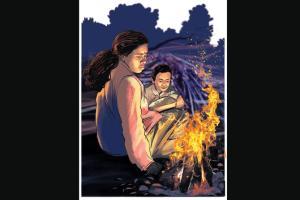The film, in Gondi, Madia, Marathi and Hindi, is produced by the NoCut Film Collective, which the directors founded, after doing the Doc Nomads Masters Course in Documentary Directing, in Europe

Illustration/Uday Mohite
![]() One of the more remarkable films I've seen this year is A Rifle and a Bag. A compelling, disarming documentary about a young Indian couple, "surrendered Naxalites", it is directed by three women filmmakers, Arya Rothe (India, from Pune, pronounced Ro-thay), Cristina Hanes (Romania) and Isabella Rinaldi (Italy). A creative documentary, it was at the International Film Festival Rotterdam this year, where it won a Jury Special Mention; at the Busan and Toronto Reel Asian International Film Festivals, and in the recent Dharamshala International Film Festival's superbly curated programme. The film, in Gondi, Madia, Marathi and Hindi, is produced by the NoCut Film Collective, which the directors founded, after doing the Doc Nomads Masters Course in Documentary Directing, in Europe.
One of the more remarkable films I've seen this year is A Rifle and a Bag. A compelling, disarming documentary about a young Indian couple, "surrendered Naxalites", it is directed by three women filmmakers, Arya Rothe (India, from Pune, pronounced Ro-thay), Cristina Hanes (Romania) and Isabella Rinaldi (Italy). A creative documentary, it was at the International Film Festival Rotterdam this year, where it won a Jury Special Mention; at the Busan and Toronto Reel Asian International Film Festivals, and in the recent Dharamshala International Film Festival's superbly curated programme. The film, in Gondi, Madia, Marathi and Hindi, is produced by the NoCut Film Collective, which the directors founded, after doing the Doc Nomads Masters Course in Documentary Directing, in Europe.
ADVERTISEMENT
We follow the lives of Somi and Sukhram, surrendered Naxalites, who are, of course, armed Maoist tribal groups, fighting for tribal rights against the Indian state. The Indian state sees them as the biggest threat to India's internal security, and under its surrender policy, Naxalites are granted pardon and incentives to desert the movement. By way of rehabilitation, the government has given the couple a small, remote plot of land for a house and small jobs. But their children can never get an education because the father is unable to produce a caste certificate (he cannot return to his home in Chhattisgarh for the certificate, for fear of being killed by those he betrayed), so the family is destined to forever remain on the margins. The Indian government knows it doesn't need guns to destroy the "enemy"—simple red tape will do the job, and far more efficiently.
It is hard not to be charmed by Somi. In the opening sequences, she chats with a friendly doctor about how she met her husband, Sukhram, in the movement. He attempted suicide twice when she turned him down, she says; the doctor says she's lucky to find someone willing to give his life for her, and Somi erupts into an epidemic of giggles. Somi and Sukhram want nothing more than to give their children an education. This film shows you how the Indian government ensures this will remain absolutely impossible; the mother's caste certificate is not good enough. Mothers? Bah! If a mother wants to send her child to school, is that a crime? If a tribal mother tries to save the jungle, is that a crime? These are some of the many issues the film raises. Of course, the Naxalite movement has a complex history; initially led by leaders seeking justice for tribals and Dalits, it has in recent decades lost much of its credibility. We meet the people behind the screaming headlines and labels "Naxalites", "Maoist", "enemies of the state": ordinary people with most basic wants—a bit of land for a home, education for their children—just like you and me.
Indian cinema has a rich history of films addressing the Naxalite movement in many languages; the documentaries include Sanjay Kak's Red Ant Dream, and fiction films include Newton, Hazaar Chaurasi ki Maa, Chakravyuh, Lal Salaam, Ko, Pratidwandi, Kaalbela, Udita Bhargava's Indo-German film Dust (Berlin Film Festival) and many more.
A Rifle and a Bag remains very low key and undramatic; yet, you are alerted to the explosive issues simmering behind the scenes. Somi is such a loving mother, with her sonorous lullabies, one would have liked to know about, if not see, her past in the armed struggle, but we don't. There is a heartbreaking sequence when the father visits their son Pravin, 6, temporarily admitted at a residential school far away, and the lonely kid bursts into tears, unable to speak (before being soon kicked out of school because of the said certificate). The cinematography, by Hanes, is distinctive: preferring still, long shots; at most times, the camera is focussed on Somi or the couple, even when they interact with others.
Much of the film is shot at night by firelight, making it evocative and also opening up spaces for reflection, elevated by meticulous sound design. It is heartwarming when the younger generation of filmmakers has the courage to pursue issues that really matter, and pushes aside labels to see people for who they really are. Bravo!
Meenakshi Shedde is India and South Asia Delegate to the Berlin International Film Festival, National Award-winning critic, curator to festivals worldwide and journalist. Reach her at meenakshi.shedde @mid-day.com
Keep scrolling to read more news
Catch up on all the latest Mumbai news, crime news, current affairs, and a complete guide from food to things to do and events across Mumbai. Also download the new mid-day Android and iOS apps to get latest updates.
Mid-Day is now on Telegram. Click here to join our channel (@middayinfomedialtd) and stay updated with the latest news
 Subscribe today by clicking the link and stay updated with the latest news!" Click here!
Subscribe today by clicking the link and stay updated with the latest news!" Click here!






